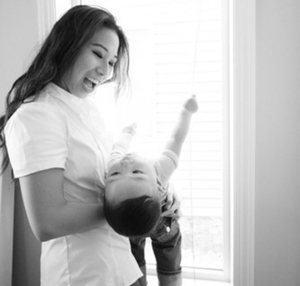Top 5 sleep routine (and sleep training) tips for parents with small children

After many tears, trial and error, I’m happy to say that my three boys consistently sleep well each night. When you have more than one baby you quickly realize how truly individual each child is. Some children are more spirited than others, and each one has different needs and bedtime negotiation tactics! As parents, we know there isn’t always one answer for all kids.
After trying many sleep training methods with my second child and none of them working, I knew I didn’t want to risk more sleepless nights with my third. I used Calm Baby Sleep Routine to transition my third baby on a good sleep routine. It is much easier to gently put your baby on a sleep routine when it’s the only thing they know, compared to breaking the well-established sleep habits of a toddler, preschooler or school-aged child.
Our top 5 tips for sleep training babies over one year, toddlers and small children are below.
1. Develop and follow a consistent feeding and sleep routine as soon as possible!
Hopefully you’ve figure out what sleep habits work for you and your family when your baby is a newborn or soon after. This is particularly helpful if you also have older children with their own scheduled activities. Know what is convenient and your preferences in terms of after school activities, your bedtime routine (dinner, playtime, bath time, snack time and story time), and what bedtime and breakfast times fit within your family’s schedule.
This also includes cutting out naps when it is appropriate. As discussed by Dr. Pam re how much sleep each child should have based on age, every child’s need for sleep is going to be different and can vary based on their age and activity level. This includes hours napped during the day plus the hours at night. (Get a free family sleep guide at the bottom of this page.)
2. Make your consistent bedtime routine a family conversation
Whatever your process, explain things clearly and make sure your child understands that the bedtime routine is not negotiable. If you’ve been using Calm Baby Sleep Routine then you’re child will likely be familiar with a well established routine. If this is new to your child, talking them through the routine and explaining what happens and when (and if appropriate, even why you do it). Your child should understand that everyone needs sleep so that they can get enough rest and be alert for the next day. Using the same words for consistency can also be helpful: it’s bedtime, I love you, time to close your eyes and go to sleep.
If your child is too young to understand words, you can use pictures on a chart or a picture book (or demonstrate yourself) to show what the rountine looks like before bed. I did this with my two youngest boys when they were little — and they loved it because we would look at the chart every rtime we were finished a step in the routine!
3. Be firm but break habits before they start
Parents should aware and okay with the habits they allow in their home. This involves knowing your preferences and which habits you are comfortable with. For example, if you don’t want your child to be dependent on a soother to put them to sleep, consider only giving them a soother when necessary from the beginning or ween them off of it (I.e., only use if you are in public and your baby is having a meltdown).
The same goes for other sleep props such as baby swings, rocking chairs, sound machines, as well as stuffed animals and special blankets for toddlers. If you’re comfortable with light shining into your child’s room, consider leaving their door open and either having a nighlight plugged into hallway outlet or even leaving the hall light on.
4. Be persistent
Do not allow your child to incorporate new things into their bedtime routine, such as extra stories, a nightlight or a glass of milk before bed.
If your child is asking for a bottle before bed, try transition to a bedtime snack instead, like cheese of yogurt. From one year onward, consider limiting liquids after dinner (1.5 to 2 hours before bedtime) to help with potty training, otherwise if can be difficult to get them to sleep through the night.
You may need to shut the nightlight (or hallway light) off if your child gets out of bed so that they know you’re serious. Or more drastic, shut their door and hold it from the outside to teach your child that they cannot get out of bed. Again, explain what is going on to your child especially if this is new to them.
If your child wakes up in the middle of the night and come to your bed, walk them back to their own bed without saying anything. This prevents them being able to negotiate with you! You may have to walk them back to bed a few times in the middle of the night for a few days before they know your serious about bedtime.
You may need to repeat the same thing over and over again until your child learns that you will not back down and that bedtime is simply not negotiable.
5. Be prepared for long nights and tears (your tears and theirs)
Unfortunately with older children, sleep training may mean tears (sometime hours of them before bed or in the middle of the night), especially when you reinforce what you say. You want your child to take you seriously. Giving in will undermine your authority.
Always check on your child if you are concerned with their wellbeing. This is where a baby monitor with a camera may come in handy.
About the Author
 Phyllis Oruclar is a wife and mother of three very loud boys. She has worked in the fashion industry for over 12 years and has a love for anything designed well.
Phyllis Oruclar is a wife and mother of three very loud boys. She has worked in the fashion industry for over 12 years and has a love for anything designed well.
Phyllis contributes to Calmparent.net because she believes in reconciling her own personal goals with being a busy mother. She is a supporter of what it represents for women – simplifying your life to find balance so that you can pursue your hobbies, or work while still being a dedicated mother. Phyllis is also a personal advocate of Calm Baby Sleep Routine which she used to get her third child on a good sleep routine.
Phyllis enjoys trying new recipes and spending time with her family. She also likes being outdoors, reading a good novel, writing and window-shopping online. Her dynamic and practical ideas are a breath of fresh air for mothers trying to maintain a sense of balance!
Sleep is so important but the optimal amount is different for each family member.
It depends on age and other factors.
Find out the healthy sleep ranges by age, for you and your growing family.
Starting with babies (newborn to one year),
toddlers, preschoolers, school aged
children, teens and adults.
Guide to optimal family sleep (daytime naps & at night)
FREE download
Be the first to know about special
offers and resources
for our community only.
Don't miss out!
Become a Calm Parent Insider
FREE gifts & resources
CALMMOTHER LIMITED © 2023 | ALL RIGHTS RESERVED
terms | privacy | contact
Simplifying life for parents so you can focus on what matters most to you.
Live your best life with kids!
+ Show / Hide Comments
Share to: